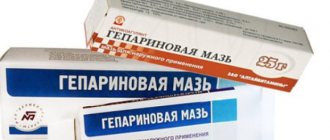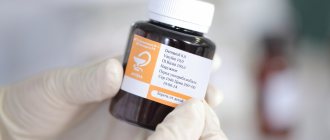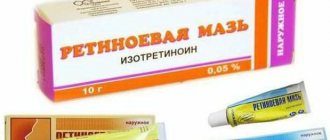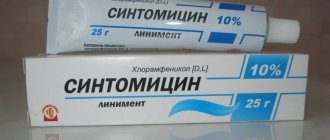Almost every adult who has at least once encountered festering wounds and scratches knows what Levomekol ointment is used for. This drug has settled firmly and for a long time in family medicine cabinets, because it is suitable even for children from 1 year old.
Contrary to erroneous belief, the ointment is used mainly for purulent wounds, and not for any wounds, as many people have become accustomed to for a long time. The drug belongs to the combined antimicrobial agents; it easily treats infected wound surfaces, even with deep cavities.
Levomekol: ointment composition, release form
Content
The drug contains 2 active ingredients - chloramphenicol and methyluracil - which complement each other's therapeutic effects. The list of auxiliary components includes:
- • macrogol 1500;
- • macrogol 400.
These substances create the usual basis of the drug in the form of a fatty ointment. It should be either white or white with a slight yellowish tint.
Levomekol ointment - brief description, composition
Levomekol ointment is intended for external use. Has a powerful antimicrobial effect on microorganisms. Acts as an effective: regenerating, anti-inflammatory agent.
Works as an antibiotic and reparative, not only cleans the wound, but also helps it heal faster. The beneficial properties of this ointment have the following components: antibiotic - chloramphenicol, immunostimulant - ethylene glycol, methyl uracil. We wrote about wound healing here.
The basis of the ointment is polyethylene oxide: 400 and 1500, it:
- provides a stable consistency;
- has an adsorbing effect;
- penetrates easily deep into.
Ethylene glycol is an auxiliary agent that helps enhance:
- general action: antibiotic and immunostimulant;
- maintains antibacterial resistance for a long time.
Levomycetin is a universal antibiotic with a wide spectrum of action. Has sensitivity to: Pseudomonas aeruginosa, streptococci, staphylococci, E. coli. Mechanism of action - has a destructive effect on pathogenic microorganisms by inhibiting protein synthesis in cells.
Methyluracil - stimulates:
- the production of interferon, this is a protein component with a powerful immunomodulatory and antiviral effect.
- increases tissue trophism.
Interferon is known to help in recovery even with multiple pathological processes.
Interferon increases immunity, has:
- anti-inflammatory properties;
- regenerating;
In 1 g. ointment is located:
- 7.5 mg of chloramphenicol - levomecithin;
- 40 mg methyluracil.
Additional connections:
- macrogol - 400;
- polyethylene oxide - 1500;
- macrogol -1500;
- polyethylene oxide -400.
"Levomekol" has a white color, but there may also be a yellowish tint. It has a homogeneous structure, general average density. They are produced in aluminum tubes: 40 g each. and in dark glass jars: 100 g, 1000 g.
pharmachologic effect
According to its pharmacological group, the ointment belongs to antimicrobial combined agents for external use. The active ingredients have anti-inflammatory and antimicrobial effects, which indicates that it does not make much sense to use it on clean wounds or minor scratches, since there are other products that are better suited for such situations.
It has a detrimental effect on many gram-positive and gram-negative bacteria, among which the most common are:
- Staphylococci.
- Pseudomonas aeruginosa.
- Escherichia coli.
Pharmacological properties
This is a universal combination drug that has:
- regenerating effect;
- antibacterial.
- anti-inflammatory
The antibacterial effect is due to chloramphenicol, it:
1) Detrimentally affects a wide range of pathogenic microorganisms.
2) Very effective, even against tenacious gram-negatives:
Staphylococcus spp. - staphylococci;
Escherichia coli - Escherichia coli;
Pseudomonas aeruginosa - Pseudomonas aeruginosa.
The regenerating effect is due to the presence of methyluracil, it:
- restores tissue structure.
Methyluracil - activates metabolism at the cellular level, promoting rapid wound healing and tissue restoration, and has an anti-edematous effect. It is a good immunostimulant and produces interferon.
“Levomekol” is capable of destroying pathogenic microorganisms, but if you add its inherent anti-edematous effect, its inherent anti-inflammatory effect is formed. When applied, it easily penetrates into cells and exerts its therapeutic effect there.
But biological membranes are not damaged; they continue to actively function and stimulate tissue regenerative processes. In the presence of purulent and necrotic masses, the antibacterial effect will be maintained.
Levomekol ointment: instructions for use, method of use and dosage
Before using the drug, the wound must be thoroughly cleaned with water and antiseptics. In this capacity you can use: an aqueous solution of chlorhexidine, potassium permanganate, furatsilin. Sometimes an infusion of chamomile or calendula is used.
Don’t be shy, ask our consultants questions, right here on the website. We will definitely answer. Leave commentsGo
Levomekol ointment: instructions for use for wounds
Using sterile gauze pads, apply ointment and leave them in the wound cavity if it is very deep. Using bandages, secure the bandage tightly until the next dressing.
If necessary, the ointment can be injected into the wound cavity using catheters and syringes, but before that it is heated to body temperature. The course of treatment is individual and depends on the speed of wound healing
Levomekol for hemorrhoids
There is often a request on the Internet about how to use Levomekol for hemorrhoids. But this item is not included in the indications for use. The drug is not used in this situation.
Levomekol for burns
For infected burns of any degree, the ointment is used in exactly the same way as for purulent wounds. They are thoroughly cleaned, and then the drug is applied and covered with gauze.
Levomekol for acne on the face
Some people treat rashes on the face with this ointment, but do not know how to apply Levomekol correctly. If the acne is purulent and inflamed, then the drug is used locally after washing and wiping the face with lotion.
Levomekol during pregnancy
No special studies have been conducted on the effectiveness and safety of the drug during this period of a woman’s life. Use is permitted only if the doctor, after weighing the pros and cons, decides that another ointment is not suitable in a particular case.
Levomekol ointment in gynecology: what helps
Currently, the ointment is practically not used for gynecological problems, because it does not adhere well to the mucous membranes. Previously, it was used for purulent infections in the vaginal cavity.
Levomekol for sunburn
For ordinary sunburns, when there are no blisters and there is no danger of infection of the resulting wound surface, there is no point in using ointment.
Levomekol for insect bites
The ointment is not used after insect bites, because it does not have antiallergic properties.
Levomekol in dentistry
The ointment is not used in dental practice, because it is quickly washed off by saliva from the mucous membranes.
What does Levomekol ointment help children with?
Many parents ask the question: “Does Levomekol draw out pus?” when they treat a festering area after a splinter with ointment. The product does not literally draw it out, but significantly reduces its amount, leaving the wound surface clean.
Use of Levomekol ointment during pregnancy
The medication can be used by both pregnant women and nursing mothers . This is explained by the fact that the ointment is used topically and is not absorbed into the bloodstream if the treated area of skin is small. Women during this period of life can treat the following diseases with Levomekol ointment:
- sinusitis and inflammation of the middle ear and ear canal;
- acne on the skin of both the face and other parts of the body;
- cuts, various abrasions, mosquito bites, minor burns;
- an inflammatory process that develops due to an ingrown nail or after a trimmed manicure.
Advice! If health problems arise, it is not advisable for pregnant and lactating women to self-prescribe and self-medicate. The right decision would be to contact a medical institution for qualified help.
Levomekol: contraindications and side effects
The ointment has no special contraindications. These include:
- Age up to 1 year.
- Individual intolerance to any of the components.
Among the side effects, allergic reactions most often occur, which occur in the form of slight itching and rashes at the site of application of the drug. Its cancellation is not required, since undesirable effects quickly pass, but if those that are not indicated in the instructions occur, you should stop using it and, if necessary, seek medical help.
How to use Levomekol ointment for the treatment of open, purulent and sutured wounds
Levomekol is a topical drug for the treatment of skin lesions.
Prescribed for rapid tissue regeneration and treatment of bacterial lesions, has a wide spectrum of action. Instructions for use of Levomekol ointment for wounds include recommendations for using the product. Levomekol is the most common drug for sterilizing wounds for various injuries. The product is available as a white or white-yellow ointment. Sold in tubes of 40 g or glass containers of 100 g or 1 kg.
Methyluracil accelerates tissue restoration, nourishes, and normalizes the metabolic processes of wounds. Chloramphenicol (or Levomycetin) is a synthetic antibiotic that copes with most known bacteria.
The ointment is a universal remedy for treating injuries of different origins and severity. Levomekol heals wounds, according to the instructions, has a quick and effective effect on cell restoration processes, dries, and stimulates metabolic processes.
To the open
Levomekol cream is used to treat cuts, scratches, burns and open wounds. Before the start of the inflammatory process, the drug helps to disinfect the damaged area, stops bleeding, promotes cell regeneration and rapid healing of even deep wounds.
Before applying the ointment, you should treat the affected area with hydrogen peroxide, a weak solution of potassium permanganate, Furacilin or another antiseptic. Hands must be disinfected to eliminate the possibility of bacterial infection.
Be sure to read the instructions for use.
Levomekol is applied to an open wound only after examination of the injury by a surgeon. The injury may need to be sutured or a foreign body removed.
For purulent
An ointment based on chloramphenicol is indispensable in the treatment of wounds, boils, acne, ulcers and acute inflammatory processes. Widely used to treat acute purulent accumulations, such as felon.
The doctor makes an incision and then applies Levomekol to the open surface. Suppuration is the result of the activity of bacteria that have entered the wound cavity for various reasons.
The antibiotic included in the composition (which can be found in the instructions) has a detrimental effect on the vital processes of microorganisms - disrupting cellular metabolism and inhibiting the ability to reproduce.
After using Levomekol, the affected area quickly clears up, inflammation, swelling, and pain disappear. Due to its powerful antibacterial properties, the ointment, according to the instructions, is used in various fields of medicine:
- surgery;
- dentistry;
- otolaryngology;
- gynecology;
- urology;
- proctology;
- cosmetology;
- dermatology;
- therapy.
The ointment, according to the instructions, promotes rapid healing, creates a protective barrier, and prevents further formation of scars.
On wired
After surgery, in the presence of stitched wounds, during the rehabilitation period it is necessary to carry out antiseptic treatment of the sutures. One of the components of therapy is Levomekol.
The drug is used in combination with other agents, creates a protective layer on the surface of the wound, and prevents pathogens from entering fresh sutures. The ointment helps speed up the healing process and cell regeneration.
The course of treatment depends on the complexity of the postoperative period, the presence of infection or the speed of tissue recovery.
For detailed information on the duration of use, please read the instructions. It may be necessary to use Levomekol after removing the stitches from the wound.
Before using Levomekol ointment, you should read the package insert included in the drug packaging. Recommendations will help avoid unexpected reactions of the body and make wound treatment more effective.
Liniment is prescribed to adults and children over 3 years of age. Sterile dressings are impregnated with the product and applied to the problem area. For deep purulent lesions or fistulas, it is possible to administer Levomekol through a drainage tube using a syringe. To do this, the drug is heated to human body temperature.
Dressings are done daily, replacing the used material with new one. Treatment, according to the instructions, should be carried out until the wound is cleared of purulent masses and the granulation process begins.
When the skin is affected by acne, Levomekol is used pointwise. Apply a thin layer using a cotton swab and leave overnight. In the morning, the remaining substance must be washed off. The course of acne treatment, according to the instructions, is about 14 days.
To eliminate gynecological diseases, Levomekol is applied to sterile dressings for treating the mucous membrane of the external genital organs or gauze swabs. In case of bacterial infection, men treat the genital organ. The medicine, according to the instructions, is relevant for use during exacerbation of hemorrhoids.
For household burns, dressing material is impregnated with chloramphenicol and applied to the affected area. The ointment helps prevent the development of infectious inflammation with further suppuration of the wound. On average, therapy lasts from 5 to 14 days.
Levomekol is well tolerated and has minor restrictions on use, as indicated in the instructions. Contraindications include hypersensitivity to individual components of the drug.
The use of liniment is prohibited for psoriasis, eczema, and fungal infections of the skin. The medicine is used in pediatrics, but is limited to age. Levomekol ointment for children should not be used on wounds if the child is under 3 years old.
According to the instructions, it is not recommended to combine liniment with drugs that affect hematopoietic processes.
In cases of overdose, as a result of the side effects of the substance, redness, rash, swelling, increased temperature of the skin area, and burning may be observed.
Balsamic liniment, or Vishnevsky ointment, has long been used as a universal remedy for various injuries or wounds of the skin. The drug contains natural ingredients - birch tar, xeroform, castor oil.
The components accelerate metabolic processes, help get rid of inflammation, relieve swelling of wounds and other unfavorable symptoms. Thanks to the ability of the drug to accelerate blood circulation in the painful area, it is possible to significantly reduce the process of tissue repair.
Liniment is prescribed for boils and purulent abscesses. The instructions will help you become more familiar with the properties. Vishnevsky’s cream copes with the function of drawing out pus much worse than Levomekol, Ichthyol, Tetracycline ointment and Synthomycin.
Liniment is contraindicated for use on non-healing wounds and those that do not stop getting wet.
Analogs
Levomekol is not the only drug that has a similar composition and principle of action according to the instructions. There are analogues of ointment for wounds, differing in manufacturer and pricing policy. Most popular:
- Levomethyl is a complete analogue, costs 50 rubles.
- Netran is a substitute, cost 90 rubles.
- Levosin is a drug based on chloramphenicol.
- Lingesin - for the treatment of external injuries with a similar principle of action, but with other substances specified in the instructions.
- Streptonitol is an effective antibacterial agent based on streptocide. It has a similar effect on infected areas.
- Salicylic-zinc paste - has an anti-inflammatory, wound-healing, keratolytic effect.
If you need to choose a substitute for the drug, you must consult with your doctor and carefully study the instructions for the analogue.
Levomekol wound healing ointment is an effective remedy that should be used exclusively as prescribed by a doctor.
Levomekol ointment: cheap analogues
The closest and cheaper analogues in composition and properties are Levosin and Levomethyl, although the first drug contains a more expanded composition of active ingredients.
Other analogues that help fight infection in wounds:
- • Baneocin;
- • Argosulfan;
- • Streptocide;
- • Hyoxyzone;
- • Bactroban;
- • Oflomelid, etc.
For the fastest and highest quality treatment, it is recommended to strictly follow the doctor’s instructions and not replace medications with others.
Indications for use
Due to the active substances included in the composition, Levomethyl helps with purulent lesions of the skin. The product should be used in the initial stages of the development of the process. In cases where surgical intervention is necessary, the ointment is recommended as a complex therapy. The main indications for the use of Levomethyl ointment, considering what it helps with, are:
- Wounds accompanied by the addition of an infectious agent. Such conditions are characterized by the presence of purulent discharge from the damaged skin area.
- Burn damage. The regenerating component of the ointment helps to quickly restore skin integrity.
- Infection after fractures.
- Acne. Local application in the area of rashes can reduce their number.
- Trophic ulcers. Complications of varicose veins require the appointment of Levomethyl for symptomatic treatment.
- Bedsores. Severe damage is accompanied by the addition of bacterial infection. The medicine is prescribed in complex therapy for the purpose of antibacterial and regenerative effects.
In the presence of the above conditions, it is recommended to prescribe Levomethyl. The advantage is the possibility of prescribing the drug for children.
Comparison of Levomekol ointment with other drugs
To help the wound heal faster, you need to choose the right treatment. To do this, you should carefully study the instructions for the medications, or even better, consult a doctor for a prescription.
Which is better: Levomekol or Vishnevsky ointment
Contrary to popular belief that Vishnevsky's liniment draws out pus, this drug is prohibited for use in acute purulent skin diseases and is an antiseptic. It is used only for clean, slow-healing wounds.
Which is better: Levosin or Levomekol
The first drug contains more active substances; in addition to its antimicrobial properties, it also has some analgesic effect.
Which is better: Oflomelid or Levomekol
Oflomelide contains lidocaine, which temporarily dulls pain, making it the drug of choice in many situations. But it also more often causes side effects in the form of allergies precisely because of this component.
Which is better: Baneocin or Levomekol
Baneocin is available in two different forms, which allows you to choose the most convenient one in each individual situation. It also has a wider spectrum of activity. It has no age-related contraindications, which makes it a good option for a family first aid kit.
Which is better: Stellanin-PEG ointment or Levomekol
The first drug is an antiseptic, so its list of indications is much longer. Its significant disadvantage is that it is contraindicated for use under 18 years of age and its high cost.
Levomekol - an antibiotic or not?
The popular ointment contains fast-acting chloramphenicol, an antibiotic. Unlike those that are used internally, this one can be used for a long time without worrying about addiction.
As a result of this composition, contraindications for use arise. Pregnant women and nursing mothers are prohibited from using the ointment. You can buy the drug at every pharmacy, therefore, this characterizes it as a safe substance.
Pregnant women and nursing mothers are prohibited from using the ointment.
There are contraindications for use in case of hypersensitivity to the agents that make up the product. Long-term use of the drug may cause skin allergies, but the results indicate that the chances are extremely low. There are no more prohibitions on the use of ointment.
Note! Levomycetin is an antibiotic in Levomekol ointment that can cope with most harmful bacteria!
Levomekol ointment: reviews
Levomekol is the most popular remedy for the treatment of various wounds on the skin, but not only that. What else is it used for?
Levomekol for acne on the face: reviews
Veronica, 19 years old, Stavropol:
Since adolescence I have suffered from acne all over my body. I tried everything possible. One day, a friend recommended Levomekol to me; the acne ointment didn’t really help me, but it managed to cure a long-unhealed infected wound next to the rashes that I intensively applied with this remedy.
I eventually cured my acne with another, more serious drug. But I left this one in the refrigerator, because I realized that it can be used in difficult cases with suppuration.
Levomekol for hemorrhoids: reviews
Vsevolod, 41 years old, Mytishchi:
There was never time to go to doctors, and there was no desire either. Therefore, I treated myself all my life on my own or with the help of advice from neighbors and friends. I did the same this time. External hemorrhoids have been causing me discomfort for quite some time. One day, a neighbor herself started a conversation about this, casually saying that ordinary Levomekol helped.
Having bought it at the nearest pharmacy, I began treatment. I can't say it's gotten better. Maybe I haven’t been using it for as long or not quite as much as I should. Nevertheless, I’m already finishing the second tube, but there is still no effect.
Levomekol on an open wound: is it possible to apply ointment to heal cuts and abrasions
Due to its effectiveness in combating suppurative processes, this drug is actively used in the treatment of open wounds in various branches of medicine.
Indications for the use of Levomekol ointment cover a whole range of dermatological, surgical, gynecological and other diseases.
Doctors can prescribe the drug for purulent processes after wound and traumatic injuries, for burns of thermal and chemical origin, to accelerate the healing of postoperative wounds, in order to cleanse and scar trophic ulcers, furunculosis, carbunculosis, abscesses, juvenile acne.
The formation of bedsores, areas with diaper rash, necrosis, frostbite, dermatological diseases complicated by purulent processes - this is what Levomekol is used for.
Levomekol is an effective anti-inflammatory, antibacterial and wound healing agent based on powerful synthetic active ingredients.
The ointment is well absorbed without changing the structure of the epidermis, and retains its therapeutic effect for a long time.
Balsamic liniment according to Vishnevsky consists of natural substances (tar, castor oil, xeroform), it acts by creating a thin film on the skin, which does not allow microorganisms to develop and multiply.
The difference between the drugs is quite significant - Levomekol has a more active effect on pathogenic flora and has a wider spectrum of action against pathogenic microbes.
The article provides detailed instructions on what Levomekol ointment is used for and why it helps most effectively. Indications in gynecology, treatment of children, comparison with Vishnevsky ointment.
Levomekol has long been considered an essential medicine and is found in every home medicine cabinet. This external remedy is well-deservedly popular because it copes with any skin problems quickly and effectively.
It has a good antibacterial effect and promotes rapid restoration of tissue structure in case of damage of various types.
The drug is actively used in surgical practice for the speedy healing of postoperative sutures, treatment of abscesses and purulent wounds. It is available because it is inexpensive and available at any pharmacy.
Compound
Available in tubes of 40g or in dark glass jars of 100g and 1000g. The consistency is medium-dense, the structure is homogeneous, slightly yellowish in color. ATX code: D06C
It contains only two active ingredients.
- Chloramphenicol is a complex chemical compound with antibacterial action, active against staphylococci, Pseudomonas aeruginosa and Escherichia coli.
- Methyluracil is a chemical substance that exhibits anabolic and anti-catabolic effects, accelerates the processes of cellular regeneration and healing of damaged tissues, and has an anti-inflammatory effect. Methyluracil easily penetrates the tissues of the human body, relieves swelling, activates metabolism at the cellular level, acts as an immunomodulator, stimulating the production of interferon.
The ratio of active ingredients per 1 gram: chloramphenicol 7.5 mg and methyluracil 40 mg.
Excipients: polyethylene oxide-400 and polyethylene oxide-1500 contribute to the uniform distribution of the active components and facilitate the penetration of the drug into the tissues. The ability for deep penetration is not associated with disruption of cell membranes, the ointment acts gently, without causing burning or unpleasant symptoms.
The drug is used as an antimicrobial, anti-inflammatory and regenerating agent. Levomekol ointment is used externally to treat a number of pathologies:
- purulent wounds and ulcers on the skin infected with pathogenic microflora;
- postoperative sutures;
- traumatic skin injuries;
- 2nd and 3rd degree burns;
- trophic ulcers;
- boils, carbuncles, abscesses, pimples, acne;
- calluses;
- bedsores;
- eczema is dry and weeping;
- necrosis;
- frostbite;
- diaper rash;
- prickly heat;
- purulent otitis;
- sinusitis.
Contraindications for use are the presence of hypersensitivity or individual intolerance to the components. Avoid contact of the ointment with the eyes, mucous membranes of the mouth and throat.
In such cases, it is necessary to rinse the eyes with plenty of water. If the ointment is accidentally swallowed, the patient's stomach is washed and activated charcoal is given.
When treating even very large areas of skin, no cases of overdose or complications were identified.
Levomekol ointment is a medicine for external use. Unless the doctor has prescribed otherwise, the product is usually applied evenly in a thin layer to the affected area, then the treated skin is covered with a sterile napkin and secured with a bandage.
Depending on the severity of the lesion, the drug is applied once or twice a day. The course of treatment is until the wound is completely cleansed and the tissue heals. Typically, the treatment period is limited to 5-10 days and ends with complete cleansing and healing.
For deep purulent and infection-complicated wounds, the ointment is heated to a temperature of 35°-36°C, then a gauze pad is soaked in it and injected directly into the wound site.
If the wound opening is very large, several wipes may be needed until the wound is completely filled. The filling should not be too dense. Afterwards a sterile fixing bandage is applied.
As the napkins become saturated with pus, they are periodically changed, the frequency of changes depends on the severity of the lesion and the volume of purulent secretion.
A sterile rubber tube (drainage) is inserted into very narrow and deep wound openings, puncture wounds, into which the drug is injected with a syringe.
What else does Levomekol ointment help with: bedsores and external purulent otitis media. To prevent bedsores in bedridden patients, the ointment is applied once a day to problem areas; during treatment, the application regimen depends on the severity of the skin lesion.
For external purulent otitis, thin sterile tourniquets are soaked in a warm preparation and shallowly inserted into the ear canal for 12 hours; it is better to do this at night.
For sinusitis, soaked tourniquets are inserted into the nasal passages.
To treat purulent acne, apply a thin layer of ointment to the affected skin at night. If the pimple opens up the next morning, the drug is placed in the resulting hole and the surrounding tissue is treated.
When treating with Levomekol, other external agents are not used.
Pregnant and lactating women can also safely use Levomekol for treatment, since this external agent is not absorbed into the systemic circulation.
If you have cracked nipples during lactation, you need to stop breastfeeding for a while, and it is best to use another remedy on the advice of a doctor. Indications for treatment with Levomekol during pregnancy, if there is no individual intolerance:
- sinusitis;
- otitis;
- cuts;
- abrasions;
- insect bites;
- ingrown toenail, panaritium;
- minor burns;
- ulcers;
- acne.
What is levomekol ointment used for in pediatrics?
In pediatrics, the drug can be prescribed even to newborns. It is used to treat umbilical wounds, abscesses after injections or vaccinations, scratches, abrasions, bruises, and to treat skin with diaper dermatitis, prickly heat and diaper rash in order to prevent infection and speed up skin regeneration.
Before using the ointment in newborns and children, first perform a skin test by applying the ointment pointwise to the crook of the elbow or under the knee, and observing whether redness or rash appears at the site of application.
As practice shows, the drug copes well with acne and acne. The method of its application depends on the number and nature of the rash.
Levomekol ointment: price in the pharmacy
Even in the smallest pharmacy you can find Levomekol, its cost is 110-150 rubles. The price may vary depending on the region and pharmacy chain.
What Levomekol ointment is used for can be read in its instructions for use. It is important to pay attention to the “Indications” section, because it indicates for which wounds this remedy is used. Many people do not know that the ointment is used only for infected wounds, and also that it is stored only in the refrigerator.
Author: Ketova Yana Dmitrievna (pharmacist)
Description of the drug
Levomethyl is a thick white ointment with a slight yellowish tint and a specific antibiotic odor. The ingredients gradually penetrate into pathological lesions, which ensures a prolonged effect of the antibacterial agent. The drug is used in the treatment of inflammatory and infectious diseases in the acute and subacute period. It is prescribed to patients with chronic recurrent pathologies. Levomethyl ointment has antimicrobial and regenerating properties and has a diverse effect on the course of diseases:
- eliminates the cause of complications - activated bacteria of pathogenic and opportunistic microflora;
- reduces the severity of clinical manifestations - swelling and irritation of the skin, pain, itching, burning;
- prevents the involvement of healthy areas of the skin and mucous membranes in the inflammatory process.
Levomethyl is often used for therapeutic and prophylactic purposes. It stops inflammation and at the same time prevents its spread.
The combined product has a more well-known structural analogue - Levomekol. The ointments have identical active and auxiliary composition, identical therapeutic properties and spectrum of action.
Pharmacological group and action
The ointment is included in the clinical and pharmacological group of combined agents for the treatment of infectious and inflammatory skin pathologies. Its therapeutic activity is based on the properties of the ingredients. Levomethyl contains levomecithin, or chloramphenicol. The antibiotic affects only bacterial cells, disrupting the synthesis of special proteins. They are necessary for microorganisms to build membranes. In the absence of proteins, the replication of RNA chains is disrupted. Cells lose their integrity and are destroyed, and bacterial reproduction becomes impossible. Levomethyl suppresses the course of the pathological process:
- destroys gram-positive and gram-negative bacteria - staphylococci, streptococci, E. coli;
- relieves acute and chronic inflammatory processes;
- normalizes microcirculation, eliminating swelling;
- improves blood circulation, stimulates the restoration of damaged tissues.
Another active ingredient of the drug is methyluracil, or dioxomethyltetrahydropyrimidine. This ingredient exhibits anabolic, anti-inflammatory, immunostimulating, leukopoietic, hematopoietic activity. Thanks to methyluracil, the processes of epithelization, tissue granulation and cell division are accelerated. It stimulates the cleansing of wounds from purulent masses and dead tissue, and increases the healing rate.
Release form and composition
Levomethyl is produced by the domestic manufacturer Zelenaya Dubrava. It is packaged in 30.0 and 40.0 g in aluminum tubes with a screw cap equipped with a tab for opening. Each of them is placed in cardboard boxes along with instructions for use. The active composition of the combined product is represented by the following ingredients:
- chloramphenicol (chloramphenicol);
- methyluracil (dioxomethyltetrahydropyrimidine).
The thick ointment base is formed from polyethylene oxides. The absence of other components in the auxiliary composition causes a low degree of absorption. Active ingredients are distributed on the surface of damaged tissues, rather than penetrating into deeper layers.
Patients often ask doctors which is better - Levomethyl or Levomekol. External agents are identical in their therapeutic effect and are prescribed to patients with purulent wounds. The only difference between the drugs is the higher cost of Levomekol.










